Career
In 1792 he was ordained and became curate of Horsley, Gloucestershire, where he remained till 1810. He then removed to Walford in Herefordshire, and remained there the rest of his life, as curate until 1830, and afterwards as vicar.
In 1799 he was elected a fellow of the Society of Antiquaries. His first important work, British Monachism (2 volumes, 1802), was a compilation, from manuscripts in the British Museum and Bodleian libraries, of facts relating to English monastic life. The work for which he is best remembered, the Encyclopaedia of Antiquities, appeared in 1824. A sequel to this, Foreign Topography, was published in 1828.
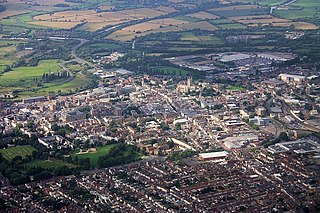
Gloucester is a cathedral city and the county town of Gloucestershire in the South West of England. Gloucester lies on the River Severn, between the Cotswolds to the east and the Forest of Dean to the west, 19 miles (31 km) east of Monmouth, and 17 miles (27 km) east of the border with Wales. Including suburban areas, Gloucester has a population of around 150,000. It is a port, linked via the Gloucester and Sharpness Canal to the Severn Estuary.

Thomas Phillips RA was a leading English portrait and subject painter. He painted many of the great men of the day including scientists, artists, writers, poets and explorers.
Richard Gough was a prominent and influential English antiquarian. He served as director of the Society of Antiquaries of London from 1771 to 1791; published a major work on English church monuments; and translated and edited a new edition of William Camden's Britannia.

Samuel Horsley was a British churchman, bishop of Rochester from 1793. He was also well versed in physics and mathematics, on which he wrote a number of papers and thus was elected a Fellow of the Royal Society in 1767; and secretary in 1773, but, in consequence of a difference with the president he withdrew in 1784.

John Kyrle, known as "the Man of Ross", was an English philanthropist, remembered for his time in Ross-on-Wye in Herefordshire.
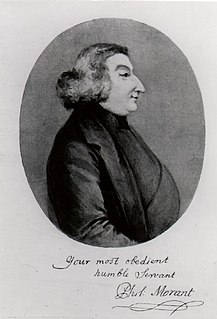
Philip Morant was an English clergyman, author and historian.

John Britton was an English antiquary, topographer, author and editor. He was a prolific populariser of the work of others, rather than an undertaker of original research. He is remembered as co-author of nine volumes in the series The Beauties of England and Wales (1801–1814); and as sole author of the Architectural Antiquities of Great Britain and Cathedral Antiquities of England.

Daniel Lysons (1762–1834) was an English antiquarian and topographer, who published, amongst other works, the four-volume Environs of London (1792–96). He collaborated on several works with his antiquarian younger brother Samuel Lysons (1763–1819).
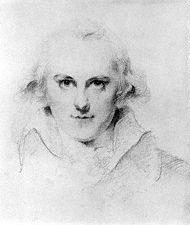
Samuel Lysons was an English antiquarian and engraver who, together with his elder brother Daniel Lysons (1762–1834), published several works on antiquarian topics. He was one of the first archaeologists to investigate Roman sites in Britain, and specialised in the study of mosaics.

Rev. George William Hall D.D. (1770–1843) was Master of Pembroke College, Oxford (1809–1843) and Vice-Chancellor of Oxford University (1820–1824).

John Gutch was an Anglican clergyman and official of the University of Oxford. He was also an antiquarian, with a particular interest in the history of the university.
English county histories, in other words historical and topographical works concerned with individual ancient counties of England, were produced by antiquarians from the late 16th century onwards. The content was variable: most focused on recording the ownership of estates and the descent of lordships of manors, thus the genealogies of county families, heraldry and other antiquarian material. In the introduction to one typical early work of this style, The Antiquities of Warwickshire published in 1656, the author William Dugdale writes:
I offer unto you my noble countriemen, as the most proper persons to whom it can be presented wherein you will see very much of your worthy ancestors, to whose memory I have erected it as a monumentall pillar and to shew in what honour they lived in those flourishing ages past. In this kind, or not much different, have divers persons in forrein parts very learnedly written; some whereof I have noted in my preface: and I could wish that there were more that would adventure in the like manner for the rest of the counties of this nation, considering how acceptable those are, which others have already performed
John Duncumb was an English clergyman and antiquary. He is best known as the author of an unfinished county history of Herefordshire.
The Rev. Prebendary James Dallaway FSA was an English antiquary, topographer, and miscellaneous writer. He is known for his account of Constantinople and the Greek islands, published in 1797; and his county history of the western parts of Sussex, of which he published two volumes in 1815–19.
Major General William Selwyn was an officer in the British Army, MP and briefly Governor of Jamaica.
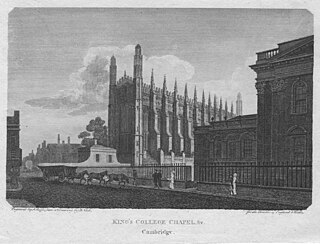
The Beauties of England and Wales (1801–1815) is a series of books describing the topography and local history of England and Wales. Produced by a variety of London publishers, the work appeared in 18 multi-part volumes arranged by county, individually authored by John Bigland, Edward Wedlake Brayley, J. Norris Brewer, John Britton, John Evans, John Hodgson, Francis Charles Laird, Joseph Nightingale, Thomas Rees, and Frederic Shoberl. Each volume contained engraved illustrations by artists such as Thomas Hearne, J. M. W. Turner, John Varley, Benjamin West. Readers included Charles Dickens.
The Rev. John Collinson was an English cleric, antiquarian and county historian. He is best known for his three-volume history of Somerset which he published at the age of 34, two years before his death, and which earned him the title of "the Somerset historian".

Gilbert Talbot, 1st Baron Talbot (1276/77–1346) was an English nobleman. He was the first of his line to hold the title of Baron Talbot, and the lineal ancestor of the Earls of Shrewsbury.

George Worrall Counsel was a Gloucester solicitor, antiquarian, alderman, and property developer.
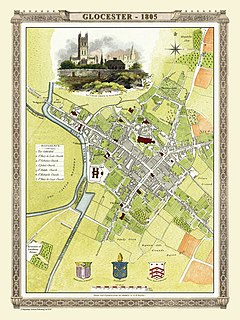
This is a bibliography of the City of Gloucester in the south-west of England. The city lies close to the Welsh border, on the River Severn, between the Cotswolds to the east and the Forest of Dean to the southwest. It was founded by the Romans under Emperor Nerva as Colonia Glevum Nervensis, and was granted its first charter in 1155 by King Henry II.














